
One nice thing about crochet is that you need only two things: a hook and yarn. Of course, there are many other useful tools and accessories that can make your crocheting life more enjoyable. Let’s explore some of the many options, beginning with the hook.
Q: What are the parts of a hook?
A: There are several different hook styles, but each has four parts: a tip or head, a throat, a shank or shaft, and a thumb rest.

Q: What are the differences among hooks?
A: Hooks are made of plastic, metal, wood, nylon, or bone. Some have a thumb rest; others have a straight shank with no thumb rest. The handle may be cushioned or shaped. Some have an inline head, while others have a tapered head with a tapered throat. When you crochet with thread, you use a steel hook that may be so tiny that you can barely see the shape of the head.
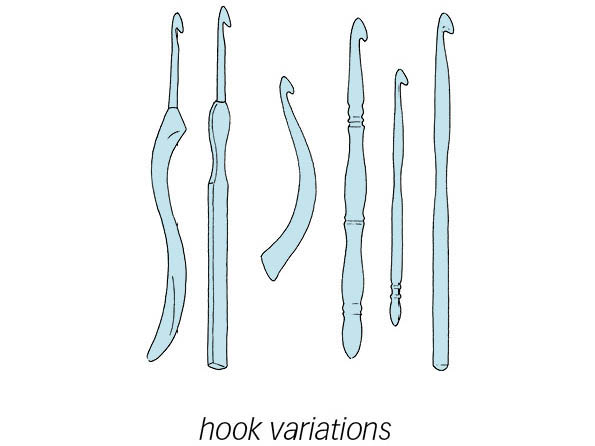
And those are just the regular hooks! There are also specialty hooks. Hooks used for Tunisian crochet have a long straight shank that resembles a knitting needle. Double-ended hooks have a hook at each end of a long straight shank. Interchangeable hook sets allow you to connect a range of different size hooks to a long cable for even more flexibility when working Tunisian or double-ended crochet.

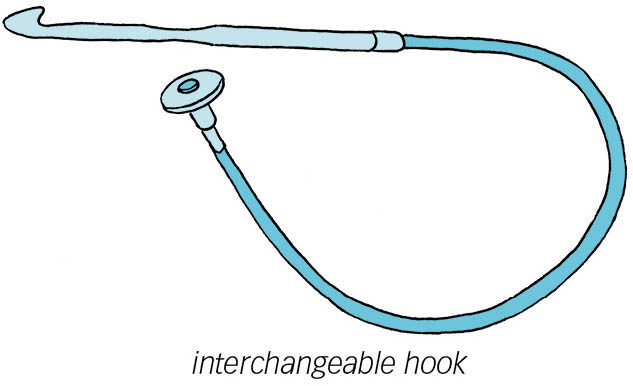
Q: With all the choices available, how do I know which hook is best?
A: Choose the style hook that is most comfortable for your hand. It should be of good quality, with no rough spots. Some people prefer to work with a certain brand of hook or with hooks made from a certain material. The length and shape of the hook handle should also be comfortable for the way you hold and manipulate it. And, of course, the size of the hook should be appropriate for the yarn or thread you are using. No matter what type of hook you have, the shank is the major determining factor in the size of the stitch.
You may find that you prefer different types of hooks for different yarn and stitch patterns. Slippery yarns like rayon might be easier to manage with a “sticky” wooden hook, while fuzzy yarns might work up faster when you use a slick aluminum hook. You may have a preference for an inline head rather than a non-inline head.
Q: What’s the difference between an inline head and another kind of head?
A: An inline head (often called “Bates” style) is one where the head of the crochet hook is no wider than the area in which the stitch is formed, while a non-inline head (often called “Boye” style) is larger than the shank to one degree or another. While no particular style is best, most crocheters have a strong preference for one type of head over another; it’s a matter of personal preference.
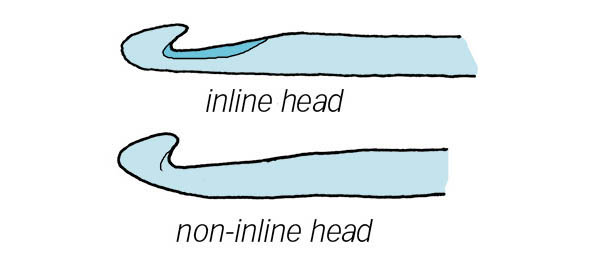
A: Hold the hook in your dominant hand in the way that is most comfortable for you. The most common ways to hold a hook are shown below. If you hold the hook a different way from those shown, and it works for you, then don’t feel you must change your technique.

pencil hold

knife hold
Q: How are hooks sized?
A: Hook sizes are described differently in different countries. Often U.S. terms include both letters and numbers; the UK and Japan each have their own numbering systems. Metric labeling is the most consistent and accurate way of describing hooks, since it is a measurement rather than a numbering system.
In the United States, standard crochet hooks range from U.S. size B/1 (2.25 mm) through jumbo size S (19 mm). But beware! Hook sizes may vary from manufacturer to manufacturer. There is no guarantee that one company’s size H/8 (5 mm) hook is the same size as another company’s, even when both are described in metric terms. In addition, numbering systems have changed over time, even with hooks from the same manufacturer. It is always best to use a hook gauge to determine the size of your hook in metric terms.
The steel hooks used for thread crochet have their own numbering system, from a tiny Japanese size 16 (.4 mm) upward.
Q: What size hook do I need?
A: Published patterns and yarn labels suggest a hook size, but this is only a starting point. You should always stitch a swatch to check your gauge. If you need to change from the suggested hook size in order to get correct gauge, then by all means do so. Having the correct gauge is always more important than using the suggested hook size.
See also: Pages 155–69 for working a swatch, Yarn Weights with Recommended Hook Sizes and Gauges.
This chart is a compilation of hook and size ranges from various sources. Keep in mind that the great variation of numbering systems over the years and from brand to brand can greatly confuse things. For example, a comparison of hook charts from a number of sources lists a 4.0 mm hook as either a G/6 or an F/5. If you aren’t following a published pattern, match the hook to the yarn or thread you are using: Larger yarns require larger hooks. Most yarn labels suggest an appropriate-sized hook for that yarn.
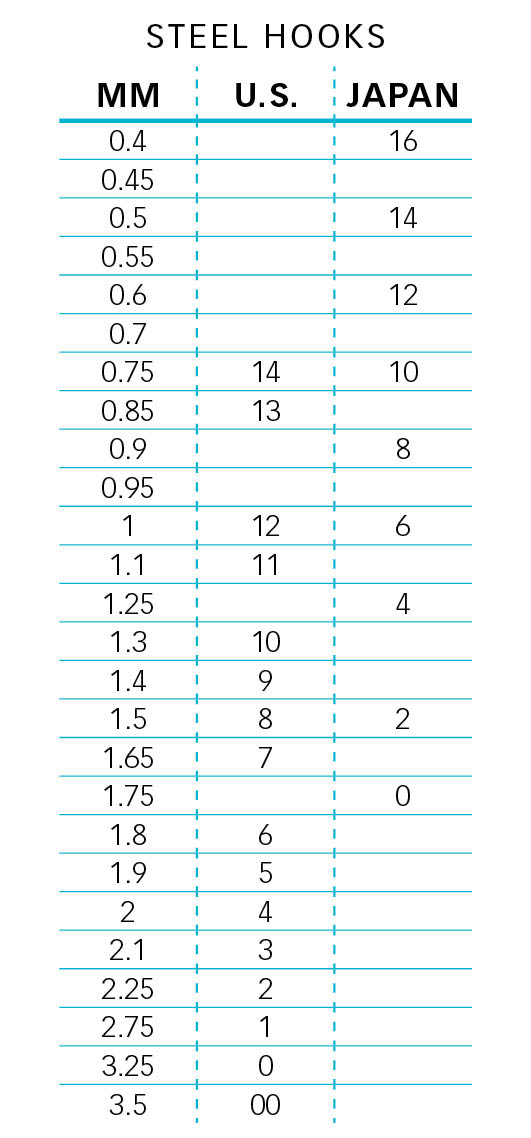
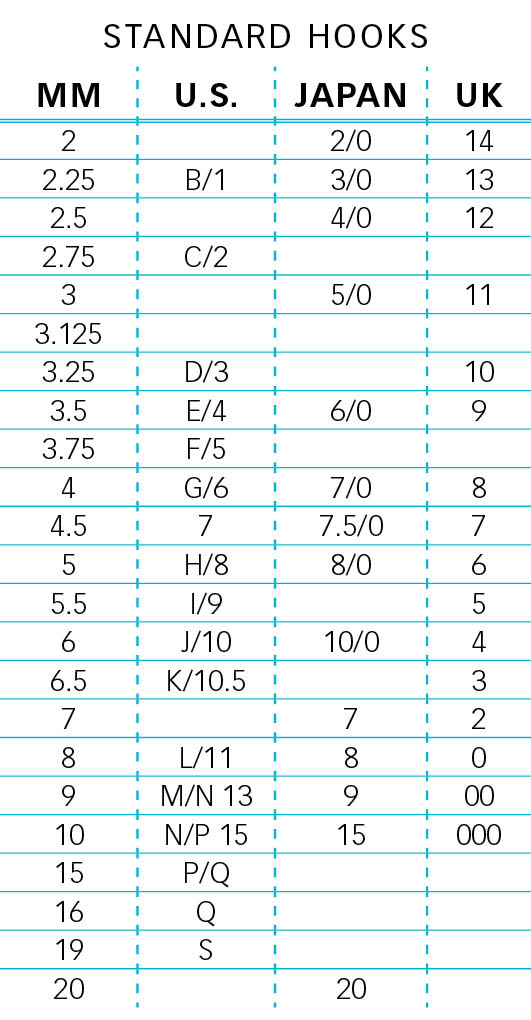
A: The yarn from the ball needs to be tensioned through the fingers of the hand not holding the hook. The end of the yarn attached to the hook goes over your forefinger. The yarn should move freely through your fingers while still being within your control. You may want to wrap it under and over other fingers in addition to your forefinger, or wrap it twice around your forefinger or pinkie. Experiment with ways to tension the yarn so that it is comfortable for you. Don’t worry if it feels awkward at first; with practice it will feel more natural.
Some people choose to hold both the yarn and the hook in their dominant hand, and throw the yarn over the hook as if they are knitting. This is not ideal; try to learn another method unless you are efficient and confident with your current method.
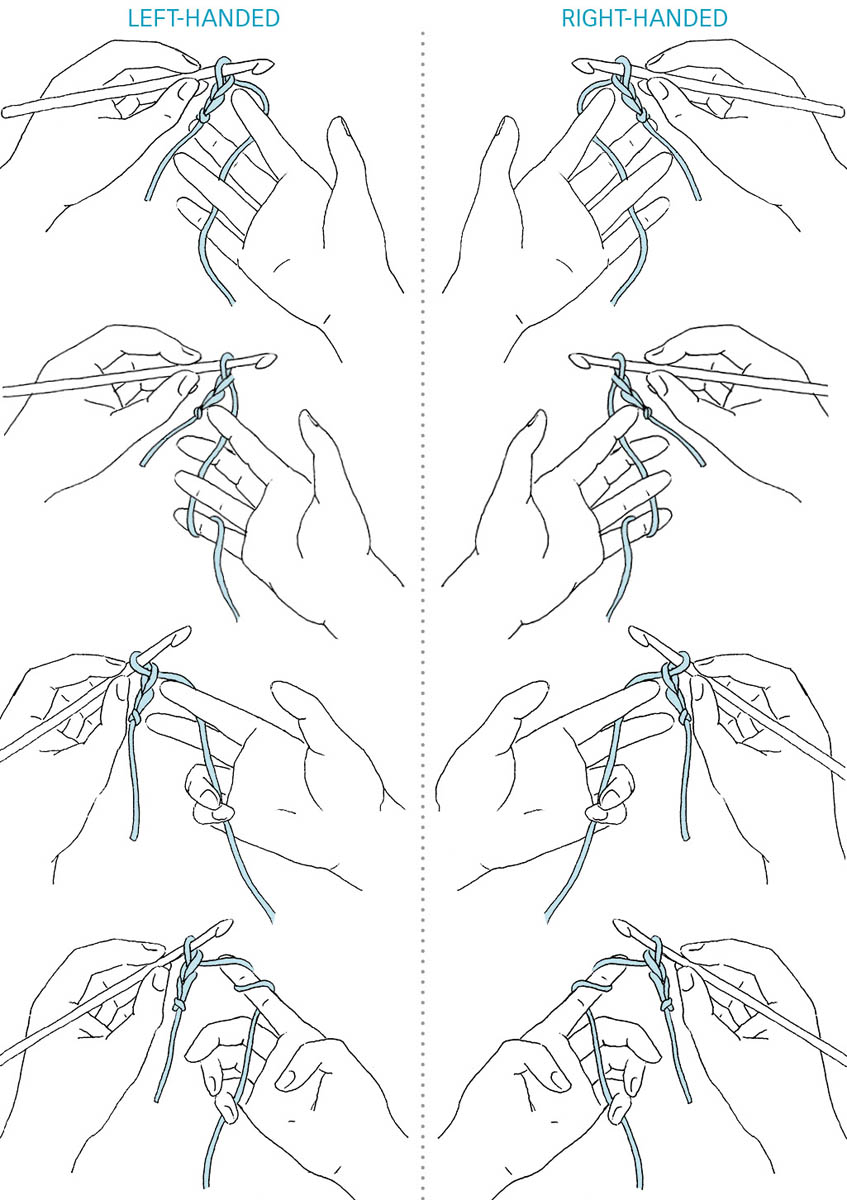
four ways to hold yarn
Q: My mother and my friend hold the hook and yarn differently. How do I know which is correct?
A: Neither is the only correct technique. It’s okay to hold the hook and the yarn in any way that is comfortable to you, even if it’s not one of the ways illustrated here. As long as you are happy with the consistency of the stitches and are comfortable while you are crocheting, you are correct.
Q: When I crochet for more than an hour, my hands and shoulders start to ache. Is there anything I can do to prevent this?
A: Sitting still and being hunched over our crochet (or our computers) for hours at a time is not a good idea. It’s really best to crochet in smaller chunks of time, with plenty of break time in between. There are a number of precautions you can take to prevent injuries from cutting into your crocheting time.
A: Certainly. Hold the hook in your left hand and the yarn in your right hand, and stitch from left to right, instead of right to left. If you are learning from a right-handed crocheter, or following a published pattern, you may have to make some adjustments, as most instructions are written for a predominantly right-handed world. If a right-hander is teaching you to crochet, sit opposite and mimic the actions you observe; you’ll be crocheting left-handed. Some books contain illustrations for both right- and left-handed stitchers; in this book, we have tried to offer both wherever appropriate.
You can follow illustrations for right-handed crochet by holding a mirror to the side of the illustration, or by scanning the illustration into your computer and flipping it horizontally on a graphics program. Because you are working from left to right, the shaping of some pieces will take place on the “other” side of the garment. In other words, if you follow cardigan instructions for the Right Front, you’ll be making the Left Front.
Note: To avoid copyright infringement, make copies for your own use only.
Some left-handed crocheters find that they can work just fine holding the hook in their right hand as right-handers do. If you can, just stitch “right-handed,” and avoid the hassle of translating your patterns to left-handed crochet.
Q: What other tools do I need?
A: Although a crochet hook is really the only tool you must have, a number of others are useful. You may want to keep a little tool bag handy, filled with some or all of these other practical tools:

See also: Pages 155–69 for swatching.

latch hook
Q: I’m really into crochet. Are there any other tools that make the work easier and even more fun?
A: There’s always something more! Ask for these great tools for your next birthday.
See also: Crocheter’s Block for blocking.
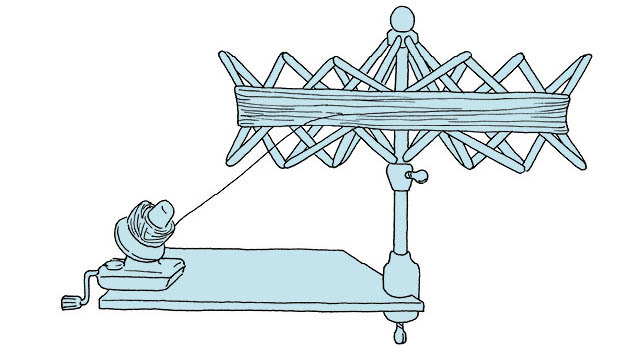
ball winder and yarn swift